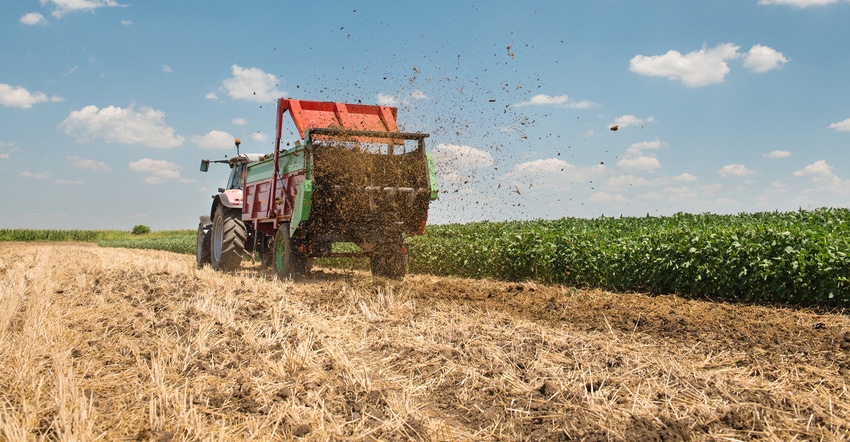May 21, 2019

By Glen Arnold
In my grandfather’s generation, summer was the most common time to apply manure. This was possible because wheat was a major player in crop rotations. Also, animal numbers per farm were much smaller, and typically only one field was needed for the manure.
Today, July and August are still usually among the warmest and driest months in Ohio. Fields are more likely to be firm, soil compaction can be minimized, and commercial manure applicators are typically more available. They are not yet in the extremely busy fall season, when the majority of the livestock manure in the state is applied.
When applying manure in the summer, follow your manure nutrient plan. If you don’t have a written plan, use your common sense. This is a good time to match soil tests with manure tests, so nutrients are properly used, and both widely and wisely distributed. This is also a good time to target fields further away from manure storages for manure application.
State payment for applying manure to wheat
The Ohio Department of Agriculture announced the Ohio Working Lands Small Grains program for the Western Lake Erie Basin earlier this year. Landowners can receive $75 per acre if manure is applied to wheat fields after harvest and a crop is planted immediately afterward. The intent is to widen the manure application window in the basin, and to get livestock farmers to start having conversations involving manure with their neighbors.
Livestock in Ohio are the ultimate recyclers of nutrients. If all the crops grown in Ohio left the state, farmers would need to buy many more tons of nitrogen, phosphorus and potash each year. The next-best recyclers of nutrients are the towns and cities whose biosolids from wastewater treatment plants are applied to Ohio fields — where the food consumed came from.
To make the best use of the nitrogen in manure, apply the manure to a growing crop. Liquid swine, beef, and dairy manures are frequently applied to forages to stimulate growth for the next cutting.
Take care applying manure to forages
One note of caution with applying manure to forages — if manure is coming from a herd with animals infected by Johne’s disease, that disease can be transmitted by manure to healthy cattle. According to a publication from the U.S. Dairy Forage Research Center at Madison, Wis., the Johne’s bacterium can survive on hay. Those authors recommended that in herds with Johne’s, manure should not be applied as a topdressing on fields that will be harvested as dry hay.
In recent years, dairy producers have made excellent use of manure when growing sudangrass for feed. Producers can often get two cuttings with favorable growing weather when the forage is planted after wheat harvest.
Summer manure application also brings up the issue of preferential flow. This is when liquid manure follows soil cracks, wormholes and crayfish holes to find field tile, and escape into ditches and streams. Dry wheat stubble fields are notorious for soil cracks. In these instances, tillage is considered the best management practice before liquid manure is applied.
If applying manure to growing crops is not an option, consider planting cover crops such as cereal rye, oats, radishes, etc. Cover crops will harvest the available nitrogen and other nutrients in the manure, and they will convert them to organic material — such as stems and roots. This eventually becomes organic matter that improves soil tilth and helps absorb rainfall. Manure can also be a preplant fertilizer for establishing alfalfa.
Test for application rate
If you are applying solid manure, again, the best use is with a growing crop, or a crop planted soon afterward, to use the nutrients. Solid manure tests indicate nutrients per ton of manure. If you can estimate the tons of manure applied to an acre, you can calculate the nutrients applied. The best way to do this is by having a small tarp that is 56 inches by 56 inches. Weigh the tarp empty, then place the tarp in a field and follow your normal manure spreading pattern. Take the tarp to be weighed with the manure collected on it. Each pound of manure collected is equal to 1 ton applied per acre. If you collected 10 pounds, your manure application rate was 10 tons per acre.
Finally, when applying manure in the summer, be neighborly. If surface-applying manure to a field you expect to till, complete the tillage operation as soon as the field is fit. Don’t allow the manure to lie there for weeks. Most livestock producers are good about this, but it only takes a few to give the others a black eye.
Arnold is a certified crop adviser with Legacy Farmers Cooperative; and a field specialist in manure nutrient management systems and an associate professor with Ohio State University Extension, Hancock County, Findlay, Ohio. Contact him at [email protected], 419-422-3851 (office) or 419-235-4724 (cell).
You May Also Like




